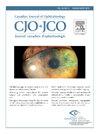Impact of COVID-19 on a real-world treat-and-extend regimen with aflibercept for neovascular age-related macular degeneration
IF 3.3
4区 医学
Q1 OPHTHALMOLOGY
Canadian journal of ophthalmology. Journal canadien d'ophtalmologie
Pub Date : 2025-02-01
DOI:10.1016/j.jcjo.2024.05.027
引用次数: 0
Abstract
Objective
To assess the effect of the COVID-19 pandemic on injection intervals among patients treated for neovascular age-related macular degeneration.
Design
Retrospective cohort study.
Participants
Patients treated at a single practice using a treat-and-extend regimen with intravitreal aflibercept between December 2018 and April 2021.
Methods
The primary outcome was the change in injection intervals. Secondary outcomes included differences in best-recorded visual acuity (BRVA) and central subfield thickness (CST). Associations were evaluated with linear mixed-effects modelling.
Results
This study included 1839 injections from 185 eyes (141 patients). The median (interquartile range) injection intervals in the pre-COVID-19 and COVID-19 periods were 60 (42–70) and 70 (49–90) days, respectively. The pandemic was associated with a mean injection interval lengthening of 7.2 days (P < 0.001), a decrease in BRVA of 3.1 Early Treatment Diabetic Retinopathy Study letters (P < 0.001), and a reduction in CST of 14.7 μm (P = 0.003). The presence of exudative intraretinal fluid was associated with a reduction in treatment intervals of 11.1 days (P < 0.001), a reduction in BRVA of 1.9 Early Treatment Diabetic Retinopathy Study letters (P < 0.001), and an increase in CST of 52.4 μm (P < 0.001). The presence of subretinal fluid was associated with a reduction in treatment intervals of 8.5 days (P < 0.001) and an increase in CST of 21.6 μm (P < 0.001).
Conclusions
This real-world study estimated that the severe acute respiratory syndrome coronavirus 2 pandemic resulted in an injection extension of 7.2 days with associated decreases in BRVA and CST that are unlikely clinically significant on a population basis. This builds on evidence suggesting that long-term vascular endothelial growth factor suppression can facilitate meaningful interval extensions while maintaining visual acuity.
Objectif
Mesurer l'effet de la pandémie de COVID-19 sur les intervalles entre les injections chez des patients traités en raison d'une dégénérescence maculaire liée à l’âge néovasculaire (DMLAn).
Nature
Étude de cohorte rétrospective.
Participants
Patients traités dans un centre unique selon un schéma thérapeutique « traitement-et-extension » qui ont reçu l'aflibercept par voie intravitréenne entre décembre 2018 et avril 2021.
Méthodes
Le paramètre principal était la modification des intervalles entre les injections. Les paramètres secondaires comprenaient les différences quant à la meilleure acuité visuelle enregistrée (MAVE) et à l’épaisseur du sous-champ central (ESC). Un modèle linéaire à effets mixtes a servi à évaluer les associations.
Résultats
L’étude portait sur 1839 injections dans 185 yeux (141 patients). Les intervalles médians (intervalles interquartiles) entre les injections avant et pendant la pandémie de COVID-19 se chiffraient à 60 (42–70) et à 70 (49–90) jours, respectivement. La pandémie a entraîné un allongement moyen de l'intervalle entre les injections de 7,2 jours (p < 0,001), une baisse de la MAVE de 3,1 lettres selon l’échelle ETDRS (Early Treatment Diabetic Retinopathy Study; p < 0,001) et une baisse de l'ESC de 14,7 μm (p = 0,003). La présence de liquide intrarétinien exsudatif était associée à une réduction de 11,1 jours (p < 0,001) de l'intervalle entre les injections, à une baisse de la MAVE de 1,9 lettre sur l’échelle ETDRS (p < 0,001) et à une hausse de l'ESC de 52,4 μm (p < 0,001). La présence de liquide sous-rétinien était associée à une réduction de 8,5 jours (p < 0,001) de l'intervalle entre les injections et à une augmentation de l'ESC de 21,6 μm (p < 0,001).
Conclusions
Selon cette étude réalisée dans le monde réel, la pandémie de SARS-CoV-2 (coronavirus 2 du syndrome respiratoire aigu sévère) a entraîné une prolongation de 7,2 jours de l'intervalle entre les injections qui s'est accompagnée d'une baisse de la MAVE et de l'ESC, phénomènes qui sont peu susceptibles de présenter une signification clinique à l’échelle de la population. Voilà qui étaye les données selon lesquelles la suppression à long terme du facteur de croissance endothélial vasculaire (VEGF) peut être soumise à des prolongations notables de l'intervalle entre les injections tout en conservant son effet sur l'acuité visuelle.
COVID-19对阿弗利百普治疗新生血管性老年性黄斑变性的 "治疗-延长 "方案的影响。
目的:评估 COVID-19 大流行对新生血管性老年黄斑变性患者注射间隔时间的影响:评估 COVID-19 大流行对新生血管性老年黄斑变性患者注射间隔的影响:设计:回顾性队列研究:在2018年12月至2021年4月期间,在一家诊所使用玻璃体内aflibercept的治疗和延长方案进行治疗的患者:主要结果是注射间隔的变化。次要结果包括最佳记录视力(BRVA)和中央子场厚度(CST)的差异。采用线性混合效应模型对相关性进行评估:这项研究包括 185 只眼睛(141 名患者)的 1839 次注射。在 COVID-19 之前和 COVID-19 期间,注射间隔的中位数(四分位数间距)分别为 60 天(42-70 天)和 70 天(49-90 天)。大流行与平均注射间隔延长 7.2 天(P < 0.001)、BRVA 减少 3.1 个早期治疗糖尿病视网膜病变研究字母(P < 0.001)和 CST 减少 14.7 μm(P = 0.003)有关。出现渗出性视网膜内积液与治疗间隔缩短 11.1 天(P < 0.001)、BRVA 降低 1.9 个早期治疗糖尿病视网膜病变研究字母(P < 0.001)和 CST 增加 52.4 μm (P < 0.001)有关。视网膜下积液的存在与治疗间隔缩短 8.5 天(P < 0.001)和 CST 增加 21.6 μm(P < 0.001)有关:这项真实世界的研究估计,严重急性呼吸系统综合征冠状病毒 2 大流行导致注射间隔延长了 7.2 天,与此相关的 BRVA 和 CST 下降在人群中不可能具有临床意义。有证据表明,长期抑制血管内皮生长因子可在保持视力的同时延长注射间隔。
本文章由计算机程序翻译,如有差异,请以英文原文为准。
求助全文
约1分钟内获得全文
求助全文
来源期刊
CiteScore
3.20
自引率
4.80%
发文量
223
审稿时长
38 days
期刊介绍:
Official journal of the Canadian Ophthalmological Society.
The Canadian Journal of Ophthalmology (CJO) is the official journal of the Canadian Ophthalmological Society and is committed to timely publication of original, peer-reviewed ophthalmology and vision science articles.

 求助内容:
求助内容: 应助结果提醒方式:
应助结果提醒方式:


